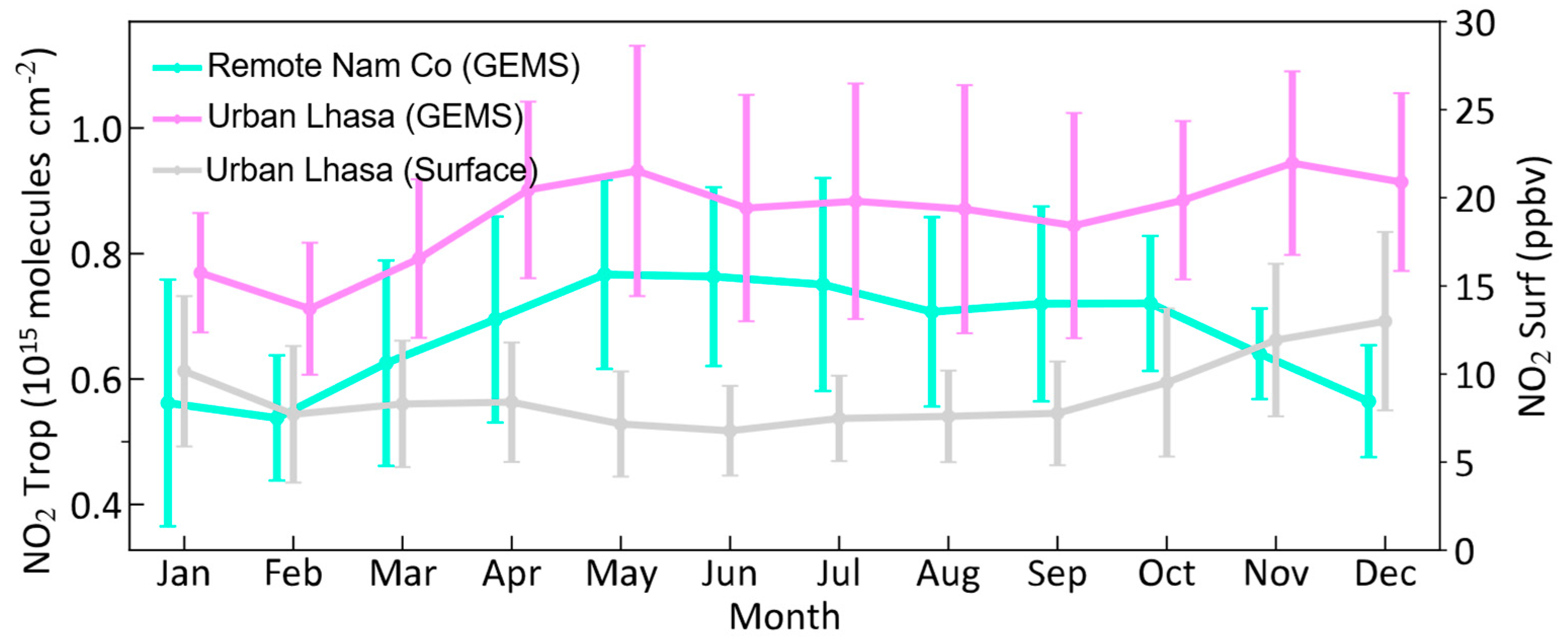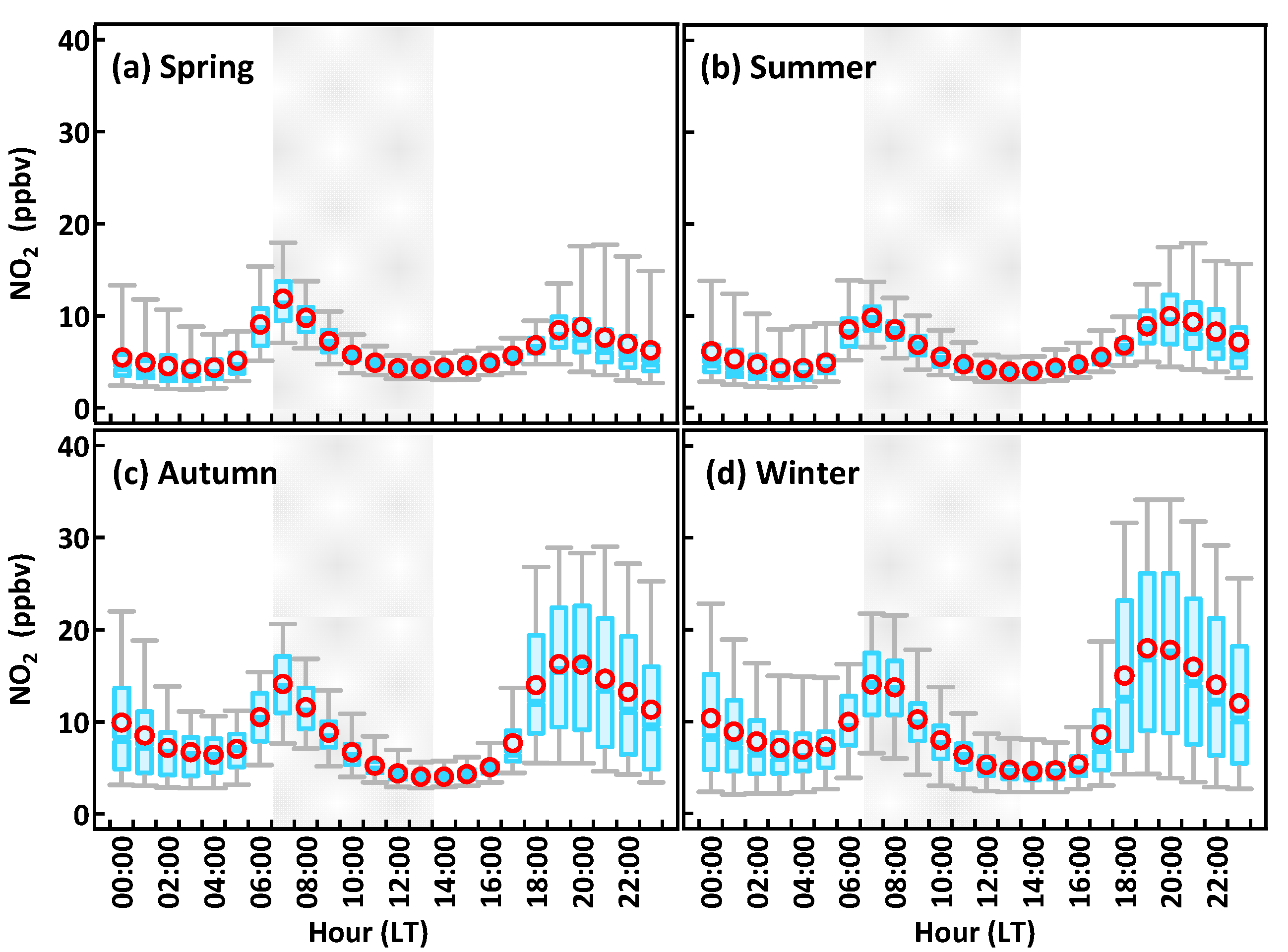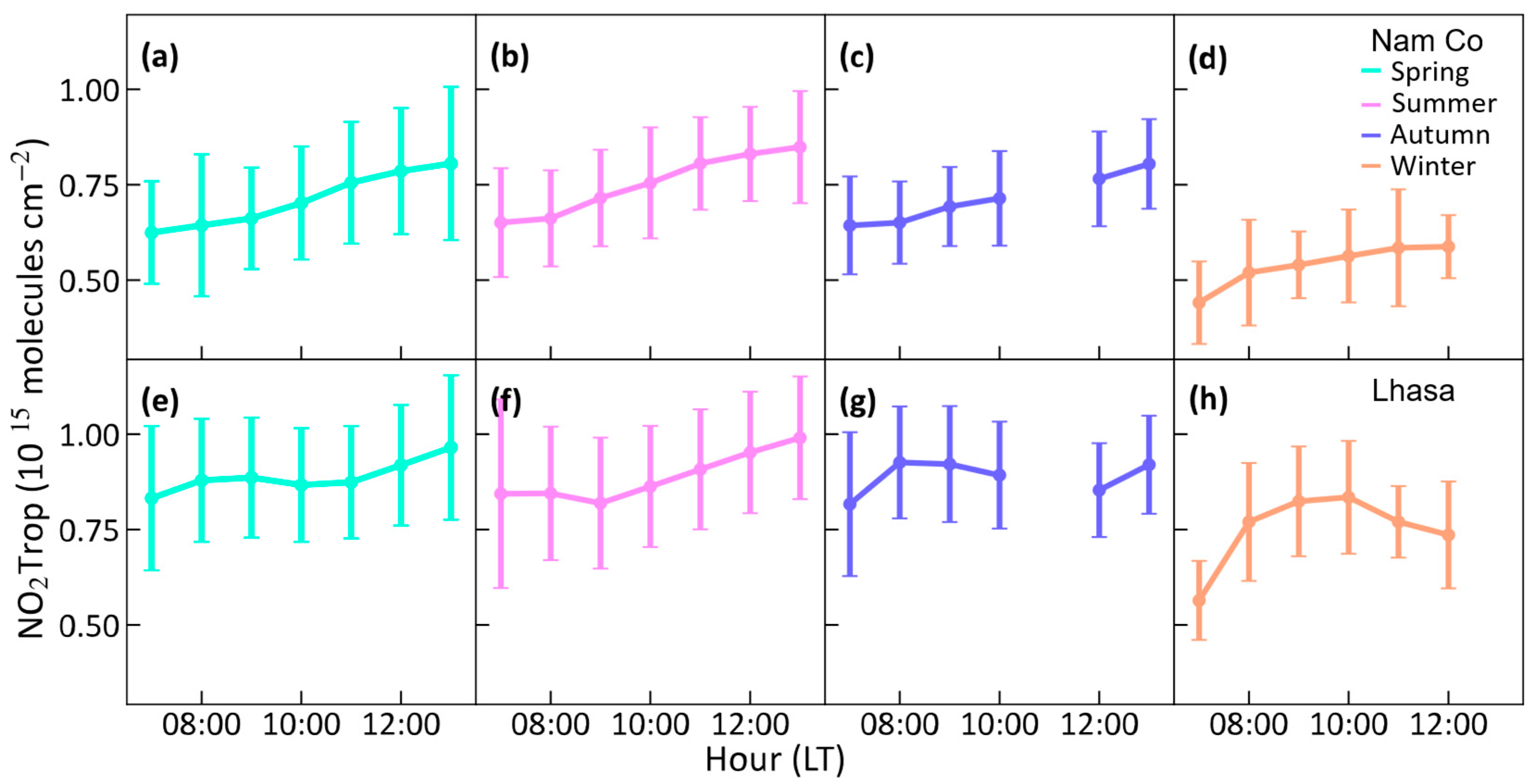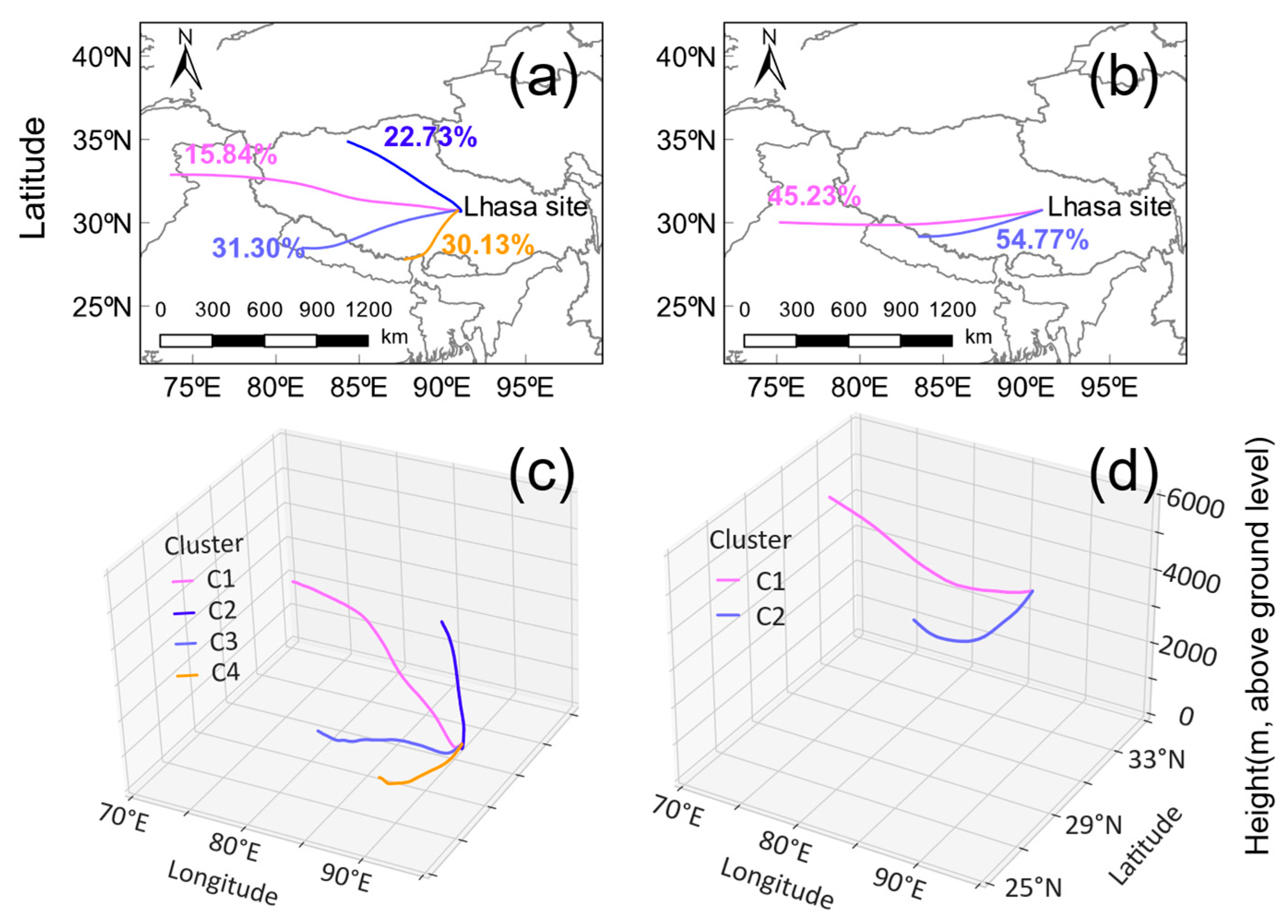Tropospheric NO2 Column over Tibet Plateau According to Geostationary Environment Monitoring Spectrometer: Spatial, Seasonal, and Diurnal Variations
Abstract
1. Introduction
2. Materials and Methods
2.1. GEMS NO2 Observations
2.2. China National Environmental Monitoring Center Surface NO2
2.3. Lagrangian Trajectory Model
3. Results
3.1. Spatial Variations of Tropospheric NO2 Vertical Column Density
3.2. Seasonal Variations of Tropospheric NO2 Vertical Column Density and Surface NO2 Concentration
3.3. Diurnal Variations of Tropospheric NO2 Vertical Column Density and Surface NO2 Concentration
4. Discussion
5. Conclusions
Author Contributions
Funding
Data Availability Statement
Conflicts of Interest
References
- Crutzen, P.J. The role of NO and NO2 in the chemistry of the troposphere and stratosphere. Annu. Rev. Earth Planet. Sci. 1979, 7, 443–472. [Google Scholar] [CrossRef]
- Seinfeld, J.H.; Pandis, S.N. Atmospheric Chemistry and Physics: From Air Pollution to Climate Change; John Wiley & Sons: Hoboken, NJ, USA, 2016. [Google Scholar]
- Galbally, I.; Roy, C. Loss of fixed nitrogen from soils by nitric oxide exhalation. Nature 1978, 275, 734–735. [Google Scholar] [CrossRef]
- Noxon, J.F. Tropospheric NO2. J. Geophys. Res. Ocean. 1978, 83, 3051–3057. [Google Scholar] [CrossRef]
- Hill, R.D.; Rinker, R.G.; Wilson, H.D.B. Atmospheric Nitrogen Fixation by Lightning. J. Atmos. Sci. 1980, 37, 179–192. [Google Scholar] [CrossRef]
- Wang, Y.; Zhu, Y.; Ye, C.; Zhou, X.; Elshorbany, Y.; Hayden, M.; Peters, A.J. Observational evidence of unknown NOx source and its perturbation of oxidative capacity in Bermuda’s marine boundary layer. J. Geophys. Res. Atmos. 2023, 128, e2023JD039582. [Google Scholar] [CrossRef]
- Honrath, R.; Peterson, M.C.; Guo, S.; Dibb, J.E.; Shepson, P.; Campbell, B. Evidence of NOx production within or upon ice particles in the Greenland snowpack. Geophys. Res. Lett. 1999, 26, 695–698. [Google Scholar] [CrossRef]
- Barbero, A.; Savarino, J.; Grilli, R.; Blouzon, C.; Picard, G.; Frey, M.; Huang, Y.; Caillon, N. New Estimation of the NOx Snow-Source on the Antarctic Plateau. J. Geophys. Res. Atmos. 2021, 126, e2021JD035062. [Google Scholar] [CrossRef]
- Burger, J.; Joyce, E.; Hastings, M.; Spence, K.; Altieri, K. A seasonal analysis of aerosol NO3− sources and NOx oxidation pathways in the Southern Ocean marine boundary layer. Atmos. Chem. Phys. 2023, 23, 5605–5622. [Google Scholar] [CrossRef]
- Wang, J.; Zhang, Y.; Zhang, C.; Wang, Y.; Zhou, J.; Whalley, L.K.; Slater, E.J.; Dyson, J.E.; Xu, W.; Cheng, P. Validating HONO as an intermediate tracer of the external cycling of reactive nitrogen in the background atmosphere. Environ. Sci. Technol. 2023, 57, 5474–5484. [Google Scholar] [CrossRef]
- Ye, C.; Zhou, X.; Zhang, Y.; Wang, Y.; Wang, J.; Zhang, C.; Woodward-Massey, R.; Cantrell, C.; Mauldin, R.L.; Campos, T.; et al. Synthesizing evidence for the external cycling of NOx in high-to low-NOx atmospheres. Nat. Commun. 2023, 14, 7995. [Google Scholar] [CrossRef]
- Qiu, J. China: The third pole. Nature 2008, 454, 393–396. [Google Scholar] [CrossRef] [PubMed]
- Davidson, E.A.; Kingerlee, W. A global inventory of nitric oxide emissions from soils. Nutr. Cycl. Agroecosyst. 1997, 48, 37–50. [Google Scholar] [CrossRef]
- Kong, H.; Lin, J.; Zhang, Y.; Li, C.; Xu, C.; Shen, L.; Liu, X.; Yang, K.; Su, H.; Xu, W. High natural nitric oxide emissions from lakes on Tibetan Plateau under rapid warming. Nat. Geosci. 2023, 16, 474–477. [Google Scholar] [CrossRef]
- Liu, Z.; Guo, F.; Zhang, Y.; Wu, Z.; Lu, X.; Deng, J.; Chen, K.; Wang, Q.; He, M. Impact of Lightning-Induced Nitrogen Oxides Over and Around the Tibetan Plateau on the Tibetan Plateau Ozone Valley. J. Geophys. Res. Atmos. 2024, 129, e2023JD039575. [Google Scholar] [CrossRef]
- Zhao, P.; Xu, X.; Chen, F.; Guo, X.; Zheng, X.; Liu, L.; Hong, Y.; Li, Y.; La, Z.; Peng, H. The third atmospheric scientific experiment for understanding the earth–atmosphere coupled system over the Tibetan Plateau and its effects. Bull. Am. Meteorol. Soc. 2018, 99, 757–776. [Google Scholar] [CrossRef]
- Kim, J.; Jeong, U.; Ahn, M.-H.; Kim, J.H.; Park, R.J.; Lee, H.; Song, C.H.; Choi, Y.-S.; Lee, K.-H.; Yoo, J.-M. New era of air quality monitoring from space: Geostationary Environment Monitoring Spectrometer (GEMS). Bull. Am. Meteorol. Soc. 2020, 101, E1–E22. [Google Scholar] [CrossRef]
- Li, Y.; Xing, C.; Peng, H.; Song, Y.; Zhang, C.; Xue, J.; Niu, X.; Liu, C. Long-term observations of NO2 using GEMS in China: Validations and regional transport. Sci. Total Environ. 2023, 904, 166762. [Google Scholar] [CrossRef]
- Lange, K.; Richter, A.; Bösch, T.; Zilker, B.; Latsch, M.; Behrens, L.K.; Okafor, C.M.; Bösch, H.; Burrows, J.P.; Merlaud, A. Validation of GEMS tropospheric NO2 columns and their diurnal variation with ground-based DOAS measurements. Atmos. Meas. Tech. 2024, 17, 6315–6344. [Google Scholar] [CrossRef]
- Park, J.; Choi, Y.; Jung, J.; Lee, K.; Yeganeh, A.K. First top-down diurnal adjustment to NOx emissions inventory in Asia informed by the Geostationary Environment Monitoring Spectrometer (GEMS) tropospheric NO2 columns. Sci. Rep. 2024, 14, 24338. [Google Scholar] [CrossRef]
- Yang, L.H.; Jacob, D.J.; Dang, R.; Oak, Y.J.; Lin, H.; Kim, J.; Zhai, S.; Colombi, N.K.; Pendergrass, D.C.; Beaudry, E. Interpreting Geostationary Environment Monitoring Spectrometer (GEMS) geostationary satellite observations of the diurnal variation in nitrogen dioxide (NO2) over East Asia. Atmos. Chem. Phys. 2024, 24, 7027–7039. [Google Scholar] [CrossRef]
- Edwards, D.P.; Martínez-Alonso, S.; Jo, D.S.; Ortega, I.; Emmons, L.K.; Orlando, J.J.; Worden, H.M.; Kim, J.; Lee, H.; Park, J. Quantifying the diurnal variation in atmospheric NO2 from Geostationary Environment Monitoring Spectrometer (GEMS) observations. Atmos. Chem. Phys. 2024, 24, 8943–8961. [Google Scholar] [CrossRef]
- Beirle, S.; Platt, U.; Glasow, R.; Wenig, M.; Wagner, T. Estimate of nitrogen oxide emissions from shipping by satellite remote sensing. Geophys. Res. Lett. 2004, 31, L18102. [Google Scholar] [CrossRef]
- Beirle, S.; Platt, U.; Wenig, M.; Wagner, T. NOx production by lightning estimated with GOME. Adv. Space Res. 2004, 34, 793–797. [Google Scholar] [CrossRef]
- Spurr, R.; Christi, M. On the generation of atmospheric property Jacobians from the (V) LIDORT linearized radiative transfer models. J. Quant. Spectrosc. Radiat. Transf. 2014, 142, 109–115. [Google Scholar] [CrossRef]
- Bucsela, E.; Krotkov, N.; Celarier, E.; Lamsal, L.; Swartz, W.; Bhartia, P.; Boersma, K.; Veefkind, J.; Gleason, J.; Pickering, K. A new stratospheric and tropospheric NO2 retrieval algorithm for nadir-viewing satellite instruments: Applications to OMI. Atmos. Meas. Tech. 2013, 6, 2607–2626. [Google Scholar] [CrossRef]
- Kim, S.; Kim, D.; Hong, H.; Chang, L.S.; Lee, H.; Kim, D.R.; Kim, D.; Yu, J.A.; Lee, D.; Jeong, U.; et al. First-time comparison between NO2 vertical columns from Geostationary Environmental Monitoring Spectrometer (GEMS) and Pandora measurements. Atmos. Meas. Tech. 2023, 16, 3959–3972. [Google Scholar] [CrossRef]
- Yang, Q.; Kim, J.; Cho, Y.; Lee, W.-J.; Lee, D.-W.; Yuan, Q.; Wang, F.; Zhou, C.; Zhang, X.; Xiao, X.; et al. A synchronized estimation of hourly surface concentrations of six criteria air pollutants with GEMS data. NPJ Clim. Atmos. Sci. 2023, 6, 94. [Google Scholar] [CrossRef]
- Ghahremanloo, M.; Choi, Y.; Singh, D. Deep learning bias correction of GEMS tropospheric NO2: A comparative validation of NO2 from GEMS and TROPOMI using Pandora observations. Environ. Int. 2024, 190, 108818. [Google Scholar] [CrossRef]
- Oak, Y.J.; Jacob, D.J.; Balasus, N.; Yang, L.H.; Chong, H.; Park, J.; Lee, H.; Lee, G.T.; Ha, E.S.; Park, R.J. A bias-corrected GEMS geostationary satellite product for nitrogen dioxide using machine learning to enforce consistency with the TROPOMI satellite instrument. Atmos. Meas. Tech. 2024, 17, 5147–5159. [Google Scholar] [CrossRef]
- Bae, K.; Song, C.K.; Van Roozendael, M.; Richter, A.; Wagner, T.; Merlaud, A.; Pinardi, G.; Friedrich, M.M.; Fayt, C.; Dimitropoulou, E.; et al. Validation of GEMS operational v2.0 total column NO2 and HCHO during the GMAP/SIJAQ campaign. Sci. Total Environ. 2025, 974, 179190. [Google Scholar] [CrossRef]
- Cheng, S.; Pu, G.; Ma, J.; Hong, H.; Du, J.; Yudron, T.; Wagner, T. Retrieval of Tropospheric NO2 Vertical Column Densities from Ground-Based MAX-DOAS Measurements in Lhasa, a City on the Tibetan Plateau. Remote Sens. 2023, 15, 4689. [Google Scholar] [CrossRef]
- Zhang, Y.; Lin, J.; Kim, J.; Lee, H.; Park, J.; Hong, H.; Van Roozendael, M.; Hendrick, F.; Wang, T.; Wang, P. A research product for tropospheric NO2 columns from Geostationary Environment Monitoring Spectrometer based on Peking University OMI NO2 algorithm. Atmos. Meas. Tech. 2023, 16, 4643–4665. [Google Scholar] [CrossRef]
- Lee, H.; Park, J.; Hyunkee, H. Geostationary Environment Monitoring Spectrometer (GEMS) User’s Guide-Nitrogen Dioxide; The National Institute of Environmental Research: Incheon, Republic of Korea, 2020. [Google Scholar]
- Schumann, U.; Huntrieser, H. The global lightning-induced nitrogen oxides source. Atmos. Chem. Phys. 2007, 7, 3823–3907. [Google Scholar] [CrossRef]
- Draxler, R.R.; Hess, G. An overview of the HYSPLIT_4 modelling system for trajectories. Aust. Meteorol. Mag. 1998, 47, 295–308. [Google Scholar]
- Wang, Y.Q. MeteoInfo: GIS software for meteorological data visualization and analysis. Meteorol. Appl. 2014, 21, 360–368. [Google Scholar] [CrossRef]
- Li, M.; Mao, J.; Chen, S.; Bian, J.; Bai, Z.; Wang, X.; Chen, W.; Yu, P. Significant contribution of lightning NOx to summertime surface O3 on the Tibetan Plateau. Sci. Total Environ. 2022, 829, 154639. [Google Scholar] [CrossRef]
- Zhu, L.; Jacob, D.J.; Keutsch, F.N.; Mickley, L.J.; Scheffe, R.; Strum, M.; González Abad, G.; Chance, K.; Yang, K.; Rappenglück, B.; et al. Formaldehyde (HCHO) As a Hazardous Air Pollutant: Mapping Surface Air Concentrations from Satellite and Inferring Cancer Risks in the United States. Environ. Sci. Technol. 2017, 51, 5650–5657. [Google Scholar] [CrossRef]
- Penner, J.E.; Bergmann, D.; Walton, J.J.; Kinnison, D.E.; Prather, M.J.; Rotman, D.A.; Price, C.G.; Pickering, K.E.; Baughcum, S.L. An evaluation of upper troposphere NO x with two models. J. Geophys. Res. 1998, 103, 22097–22113. [Google Scholar] [CrossRef]
- Tie, X.; Zhang, R.; Brasseur, G.P.; Emmons, L.K.; Lei, W. Effects of lightning on reactive nitrogen and nitrogen reservoir species in the troposphere. J. Geophys. Res. 2001, 106, 3167–3178. [Google Scholar] [CrossRef]
- Labrador, L.; Kuhlmann, R.v.; Lawrence, M.G. The effects of lightning-produced NOx and its vertical distribution on atmospheric chemistry: Sensitivity simulations with MATCH-MPIC. Atmos. Chem. Phys. 2004, 5, 1815–1834. [Google Scholar] [CrossRef]
- Boersma, K.F.; Eskes, H.J.; Meijer, E.W.; Kelder, H.M. Estimates of lightning NOx production from GOME satellite observations. Atmos. Chem. Phys. 2005, 5, 2311–2331. [Google Scholar] [CrossRef]
- Xu, W.; Bian, Y.; Lin, W.; Zhang, Y.; Wang, Y.; Ma, Z.; Zhang, X.; Zhang, G.; Ye, C.; Xu, X. O3 and PAN in southern Tibetan Plateau determined by distinct physical and chemical processes. Atmos. Chem. Phys. 2023, 23, 7635–7652. [Google Scholar] [CrossRef]
- Xu, X.; Zhang, H.; Lin, W.; Wang, Y.; Xu, W.; Jia, S. First simultaneous measurements of peroxyacetyl nitrate (PAN) and ozone at Nam Co in the central Tibetan Plateau: Impacts from the PBL evolution and transport processes. Atmos. Chem. Phys. 2018, 18, 5199–5217. [Google Scholar] [CrossRef]
- Wu, C.; Yu, J.Z. Evaluation of linear regression techniques for atmospheric applications: The importance of appropriate weighting. Atmos. Meas. Tech. 2018, 11, 1233–1250. [Google Scholar] [CrossRef]
- Rai, M.; Kang, S.; Yang, J.; Chen, X.; Hu, Y.; Rupakheti, D. Tracing atmospheric anthropogenic black carbon and its potential radiative response over Pan-third Pole region: A synoptic-scale analysis using WRF-chem. J. Geophys. Res. Atmos. 2022, 127, e2021JD035772. [Google Scholar] [CrossRef]
- Zhang, X.; Xu, W.; Song, X.; Duan, X.; Peng, X.; Lin, W.; Zhao, G.; Zhang, G.; Xu, X.; Jin, J. Cross-Regional Horizontal and Vertical Transport Pathways of Carbon Monoxide and Its Impact on Air Pollution in the Tibetan Plateau. J. Geophys. Res. Atmos. 2025, 130, e2024JD041859. [Google Scholar] [CrossRef]
- Qie, X.; Wu, X.; Yuan, T.; Bian, J.; Lu, D. Comprehensive Pattern of Deep Convective Systems over the Tibetan Plateau–South Asian Monsoon Region Based on TRMM Data. J. Clim. 2014, 27, 6612–6626. [Google Scholar] [CrossRef]






Disclaimer/Publisher’s Note: The statements, opinions and data contained in all publications are solely those of the individual author(s) and contributor(s) and not of MDPI and/or the editor(s). MDPI and/or the editor(s) disclaim responsibility for any injury to people or property resulting from any ideas, methods, instructions or products referred to in the content. |
© 2025 by the authors. Licensee MDPI, Basel, Switzerland. This article is an open access article distributed under the terms and conditions of the Creative Commons Attribution (CC BY) license (https://creativecommons.org/licenses/by/4.0/).
Share and Cite
Zhang, X.; Ye, C.; Kim, J.; Lee, H.; Park, J.; Jung, Y.; Hong, H.; Fu, W.; Li, X.; Chen, Y.; et al. Tropospheric NO2 Column over Tibet Plateau According to Geostationary Environment Monitoring Spectrometer: Spatial, Seasonal, and Diurnal Variations. Remote Sens. 2025, 17, 1690. https://doi.org/10.3390/rs17101690
Zhang X, Ye C, Kim J, Lee H, Park J, Jung Y, Hong H, Fu W, Li X, Chen Y, et al. Tropospheric NO2 Column over Tibet Plateau According to Geostationary Environment Monitoring Spectrometer: Spatial, Seasonal, and Diurnal Variations. Remote Sensing. 2025; 17(10):1690. https://doi.org/10.3390/rs17101690
Chicago/Turabian StyleZhang, Xue, Chunxiang Ye, Jhoon Kim, Hanlim Lee, Junsung Park, Yeonjin Jung, Hyunkee Hong, Weitao Fu, Xicheng Li, Yuyang Chen, and et al. 2025. "Tropospheric NO2 Column over Tibet Plateau According to Geostationary Environment Monitoring Spectrometer: Spatial, Seasonal, and Diurnal Variations" Remote Sensing 17, no. 10: 1690. https://doi.org/10.3390/rs17101690
APA StyleZhang, X., Ye, C., Kim, J., Lee, H., Park, J., Jung, Y., Hong, H., Fu, W., Li, X., Chen, Y., Wu, X., Li, Y., Li, J., Zhang, P., Yan, Z., Zhang, J., Liu, S., & Zhu, L. (2025). Tropospheric NO2 Column over Tibet Plateau According to Geostationary Environment Monitoring Spectrometer: Spatial, Seasonal, and Diurnal Variations. Remote Sensing, 17(10), 1690. https://doi.org/10.3390/rs17101690








